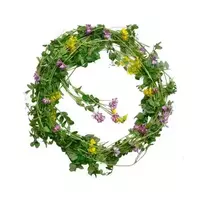China plant

The china plant is mainly used as a technical agricultural crop - in some countries of the world it is deliberately cultivated for the feed of livestock and for the purpose of harvesting hay. However, it also finds its place in cooking.
In a herbaceous plant, the rank on the curly stem is oblong sharp leaves with antennae at the ends. The flowers of the rank belong to the moth type, which is characteristic of the legume family. The color scheme of this interesting plant is striking in its variety: snow-white, pinkish, orange, yellow, purple or purple inflorescences are found. Moreover, according to the color of the bean, the ranks that are tied after flowering can be light-seeded, dark-seeded and white-seeded.
Interestingly, the closest relative of the rank is the well-known sweet peas, bred by Henry Ackford based on a nondescript but very fragrant flower. By the way, in the Victorian era, this fact became a real sensation.
Today, in a wild form, the rank plant is found in the steppe expanses, on forest edges and in fields in the temperate climatic conditions of South America, the Mediterranean, China, northwestern Africa and the Far East. In Europe, whole meadows are even planted, where the plant can adhere from the first sowing to ten years.
Domestic and foreign gardeners like to grow ranks not only for decorative purposes - the seeds of this plant can be used to make fabrics, plywood and plastic. In addition, in boiled form, beans are very tasty and nutritious, and young shoots of the plant are an excellent supplement to soups, cabbage soup, salads and snacks.
Composition of the rank
Such biologically active substances as carotene, vitamin PP, organic copper, iron, chromium, manganese, magnesium, aluminum and many others were found in the rank. In addition, mono- and disaccharides, dietary fiber, ash and starch are contained in this plant.
The benefits of the rank
The benefits of rank for the human body are especially relevant during spring vitamin deficiency, since its use contributes to the strengthening of immunity and the creation of a natural barrier from colds.
As an effective folk remedy, it is advised to use an infusion of ranks, which has an exhilarating effect, which helps with bronchitis, pneumonia, tuberculosis, bronchiectatic disease and lung abscess. In addition, the benefits of the rank have been proven in the treatment of diarrhea, insomnia, gastrointestinal diseases and the cardiovascular system - then it is recommended to use a decoction of the rhizomes of this plant.
Harm to the rank
Nevertheless, this plant also has its own contraindications. In particular, harm to the rank is quite possible when using large amounts of beans that can provoke poisoning - latirism. The main symptoms of it are suffocation along with paralysis of the limbs.
plants with a rank of 286 kCal
The energy value of the plant is rank (Ratio of proteins, fats, carbohydrates - ju):
Proteins: 24.4 g (98 kCal ~)
Fats: 2.2 g (~ 20 kCal)
Carbohydrates: 41.3g (~ 165kCal)
Energy ratio (b | y): 34% | 7% | 58%
 Español
Español Français
Français Português
Português Русский
Русский 简体中文
简体中文 繁體中文
繁體中文 日本語
日本語 한국어
한국어 العربية
العربية Türkçe
Türkçe Қазақ
Қазақ Deutsch
Deutsch Italiano
Italiano Українська
Українська
